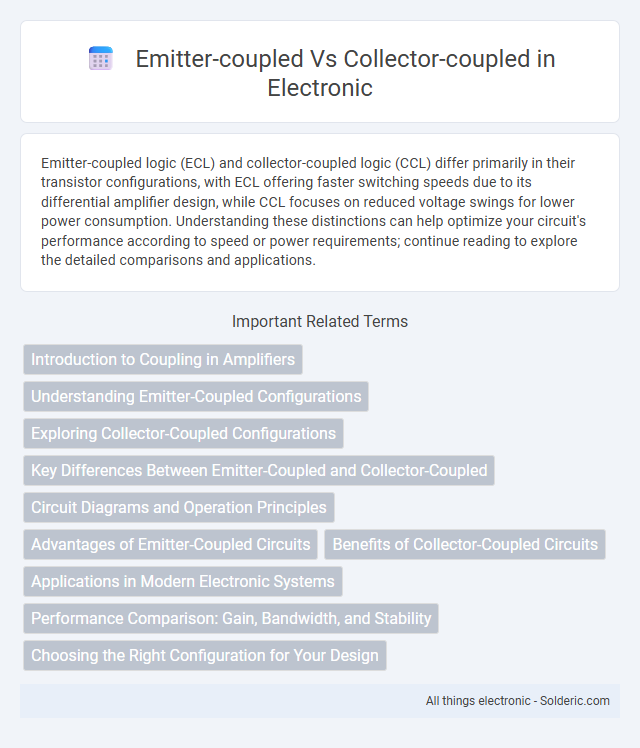Emitter-coupled logic (ECL) and collector-coupled logic (CCL) differ primarily in their transistor configurations, with ECL offering faster switching speeds due to its differential amplifier design, while CCL focuses on reduced voltage swings for lower power consumption. Understanding these distinctions can help optimize your circuit's performance according to speed or power requirements; continue reading to explore the detailed comparisons and applications.
Comparison Table
| Feature | Emitter-Coupled Logic (ECL) | Collector-Coupled Logic (CCL) |
|---|---|---|
| Speed | Very high-speed switching, typically in the picosecond to low nanosecond range | Moderate speed, slower than ECL due to additional voltage drop and capacitance |
| Power Consumption | High power dissipation because of constant current biasing | Lower power consumption relative to ECL |
| Voltage Swing | Small voltage swing (~0.8 V), resulting in less noise margin | Larger voltage swing compared to ECL, improves noise margin |
| Complexity | More complex circuit design due to differential pair and constant current source | Simpler circuit structure; uses transistor collectors as outputs |
| Logic Levels | Uses differential logic levels for improved speed and noise immunity | Uses single-ended logic levels typical of bipolar transistor logic |
| Applications | High-speed digital systems, communication circuits requiring ultra-fast switching | Moderate speed applications where power efficiency is more critical |
Introduction to Coupling in Amplifiers
Coupling in amplifiers is a crucial technique that connects different stages to ensure efficient signal transfer with minimal loss. Emitter-coupled amplifiers use the common emitter to achieve high gain and improved input-output isolation, while collector-coupled amplifiers utilize the collector for better voltage swing and wider bandwidth. Understanding these coupling methods helps you optimize amplifier design for specific performance requirements, balancing gain, linearity, and frequency response.
Understanding Emitter-Coupled Configurations
Emitter-coupled configurations, commonly found in differential pairs, provide high gain and fast switching by leveraging the shared emitter node for precise current steering, which enhances linearity and improves noise immunity. These configurations excel in analog and digital circuits where balanced input signals require accurate amplification and minimal distortion. The tight coupling at the emitter ensures better control of transistor operation compared to collector-coupled designs, making emitter-coupled circuits ideal for high-speed and high-frequency applications.
Exploring Collector-Coupled Configurations
Collector-coupled configurations offer improved voltage gain and better high-frequency performance compared to emitter-coupled designs by leveraging the collector terminals for signal coupling. These configurations reduce gain-bandwidth trade-offs and provide enhanced linearity in analog circuits such as operational amplifiers and differential pairs. The utilization of collector-coupled stages is critical in high-speed applications requiring precise signal amplification and noise reduction.
Key Differences Between Emitter-Coupled and Collector-Coupled
Emitter-coupled circuits have their outputs connected at the emitters of transistors, resulting in lower input impedance and faster switching speeds compared to collector-coupled circuits, which connect outputs at the collectors and provide higher voltage swings but slower response times. You should consider that emitter-coupled designs are preferred for high-speed applications due to their superior frequency response, while collector-coupled configurations offer better voltage gain and output voltage range. The key differences hinge on their connection points, affecting input/output impedance, switching speed, and voltage swing capabilities.
Circuit Diagrams and Operation Principles
Emitter-coupled circuits feature differential pairs with emitters connected through a current source, allowing precise control of current flow and high-speed switching, as seen in classic differential amplifier diagrams. Collector-coupled designs connect collector terminals and rely on load resistors or active loads, offering increased voltage gain but typically slower operation due to transistor saturation effects. Your choice between emitter-coupled and collector-coupled configurations impacts the circuit's speed, gain, and power consumption based on these fundamental operational principles and schematic layouts.
Advantages of Emitter-Coupled Circuits
Emitter-coupled circuits offer superior speed and higher gain due to their low input impedance and differential operation, making them ideal for high-frequency applications. Their strong common-mode noise rejection enhances signal integrity in noisy environments. The symmetrical design of emitter-coupled pairs ensures consistent performance and reduced distortion compared to collector-coupled configurations.
Benefits of Collector-Coupled Circuits
Collector-coupled circuits offer improved voltage gain and higher output impedance compared to emitter-coupled designs, making them suitable for high-frequency applications. Their structure provides better noise immunity and enhanced linearity, resulting in more precise signal amplification. The ability to achieve greater voltage swings without compromising stability highlights the collector-coupled circuit's advantages in analog signal processing.
Applications in Modern Electronic Systems
Emitter-coupled logic (ECL) is favored in high-speed digital circuits such as communication systems and supercomputers due to its fast switching capabilities and low propagation delay. Collector-coupled logic (CCL) offers improved noise immunity and power efficiency, making it suitable for mixed-signal systems and low-power applications. Your choice between ECL and CCL directly impacts system performance, balancing speed requirements and power consumption in modern electronic design.
Performance Comparison: Gain, Bandwidth, and Stability
Emitter-coupled circuits generally offer higher gain and wider bandwidth due to their better transconductance and lower output impedance, making them ideal for high-frequency applications. In contrast, collector-coupled configurations provide improved stability and linearity but at the cost of reduced gain and narrower bandwidth. Performance trade-offs emphasize emitter-coupling for speed and amplification, while collector-coupling favors stable operation in precision analog circuits.
Choosing the Right Configuration for Your Design
Emitter-coupled logic (ECL) offers faster switching speeds and lower voltage swings, ideal for high-frequency applications, while collector-coupled logic (CCL) provides better voltage gain and simpler collector load design suitable for moderate speed circuits. Selecting the right configuration depends on the trade-off between speed, power consumption, and circuit complexity with ECL favoring speed-critical designs and CCL favoring power efficiency and simplicity. Accurate assessment of system requirements like frequency response and power budget ensures optimal performance and reliability in integrated circuit design.
emitter-coupled vs collector-coupled Infographic

 solderic.com
solderic.com